Uwe Kruger
Dynamic directed functional connectivity as a neural biomarker for objective motor skill assessment
Feb 19, 2025Abstract:Objective motor skill assessment plays a critical role in fields such as surgery, where proficiency is vital for certification and patient safety. Existing assessment methods, however, rely heavily on subjective human judgment, which introduces bias and limits reproducibility. While recent efforts have leveraged kinematic data and neural imaging to provide more objective evaluations, these approaches often overlook the dynamic neural mechanisms that differentiate expert and novice performance. This study proposes a novel method for motor skill assessment based on dynamic directed functional connectivity (dFC) as a neural biomarker. By using electroencephalography (EEG) to capture brain dynamics and employing an attention-based Long Short-Term Memory (LSTM) model for non-linear Granger causality analysis, we compute dFC among key brain regions involved in psychomotor tasks. Coupled with hierarchical task analysis (HTA), our approach enables subtask-level evaluation of motor skills, offering detailed insights into neural coordination that underpins expert proficiency. A convolutional neural network (CNN) is then used to classify skill levels, achieving greater accuracy and specificity than established performance metrics in laparoscopic surgery. This methodology provides a reliable, objective framework for assessing motor skills, contributing to the development of tailored training protocols and enhancing the certification process.
Integrating AI in College Education: Positive yet Mixed Experiences with ChatGPT
Jul 08, 2024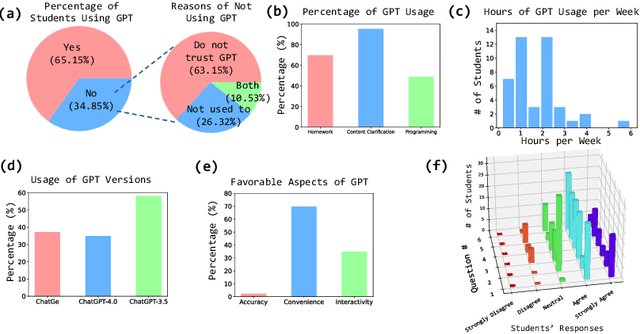
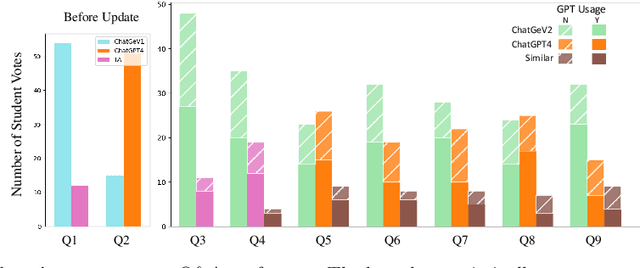
Abstract:The integration of artificial intelligence (AI) chatbots into higher education marks a shift towards a new generation of pedagogical tools, mirroring the arrival of milestones like the internet. With the launch of ChatGPT-4 Turbo in November 2023, we developed a ChatGPT-based teaching application (https://chat.openai.com/g/g-1imx1py4K-chatge-medical-imaging) and integrated it into our undergraduate medical imaging course in the Spring 2024 semester. This study investigates the use of ChatGPT throughout a semester-long trial, providing insights into students' engagement, perception, and the overall educational effectiveness of the technology. We systematically collected and analyzed data concerning students' interaction with ChatGPT, focusing on their attitudes, concerns, and usage patterns. The findings indicate that ChatGPT offers significant advantages such as improved information access and increased interactivity, but its adoption is accompanied by concerns about the accuracy of the information provided and the necessity for well-defined guidelines to optimize its use.
Video-based Formative and Summative Assessment of Surgical Tasks using Deep Learning
Mar 17, 2022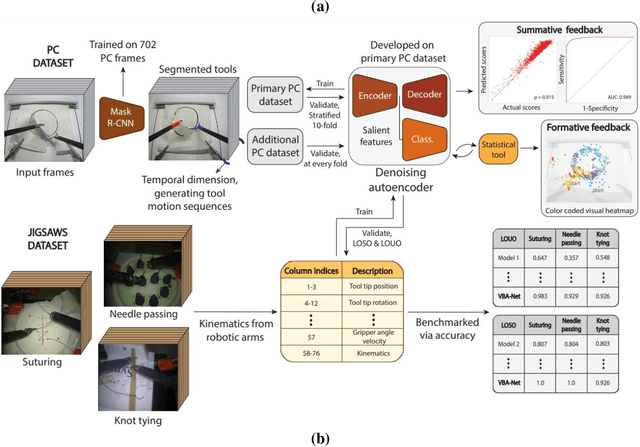
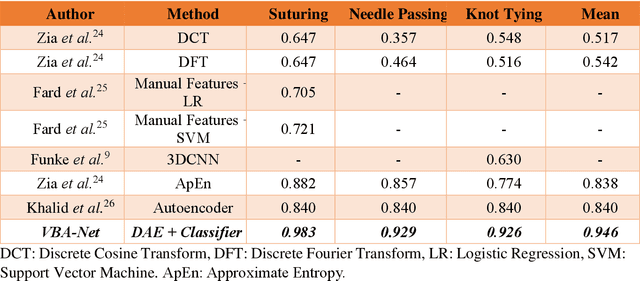
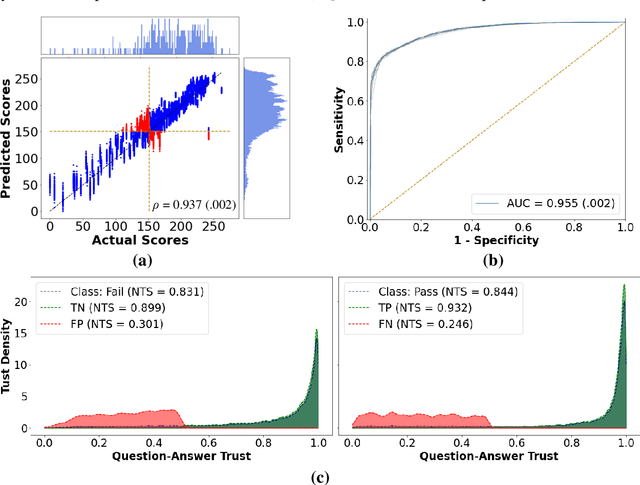

Abstract:To ensure satisfactory clinical outcomes, surgical skill assessment must be objective, time-efficient, and preferentially automated - none of which is currently achievable. Video-based assessment (VBA) is being deployed in intraoperative and simulation settings to evaluate technical skill execution. However, VBA remains manually- and time-intensive and prone to subjective interpretation and poor inter-rater reliability. Herein, we propose a deep learning (DL) model that can automatically and objectively provide a high-stakes summative assessment of surgical skill execution based on video feeds and low-stakes formative assessment to guide surgical skill acquisition. Formative assessment is generated using heatmaps of visual features that correlate with surgical performance. Hence, the DL model paves the way to the quantitative and reproducible evaluation of surgical tasks from videos with the potential for broad dissemination in surgical training, certification, and credentialing.
Deep Neural Networks for the Assessment of Surgical Skills: A Systematic Review
Mar 03, 2021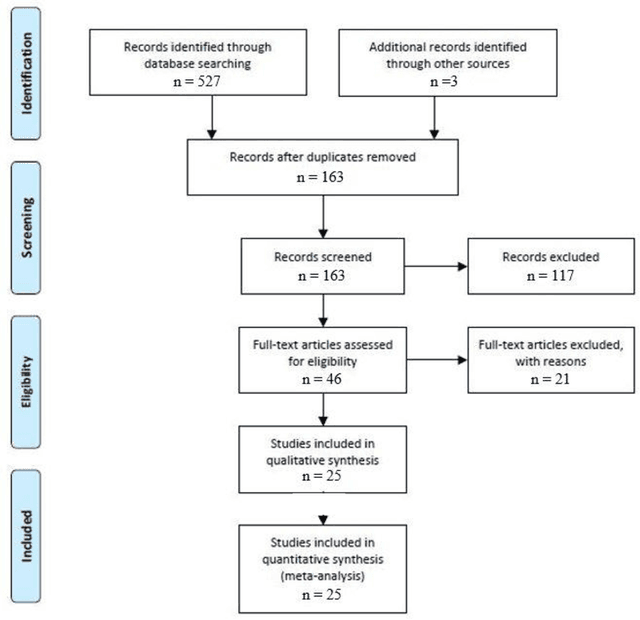
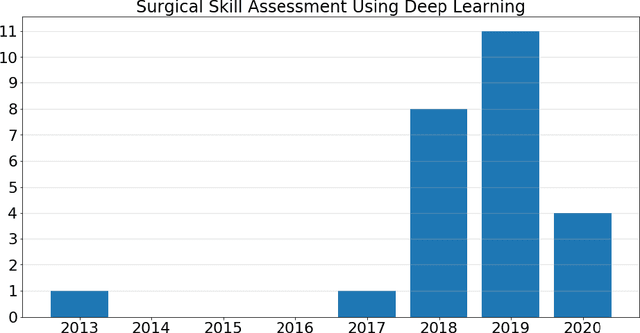
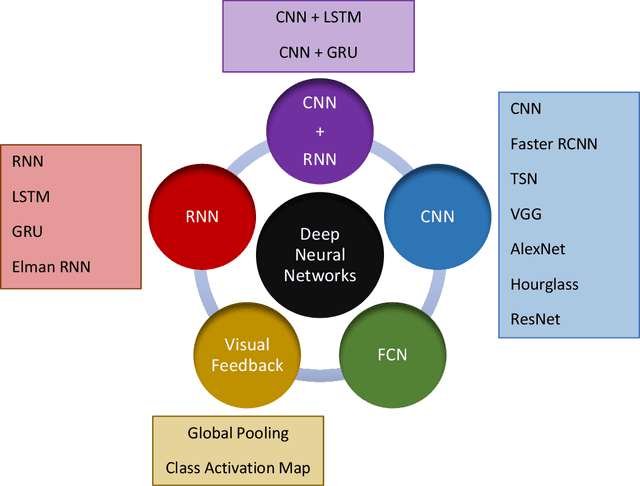
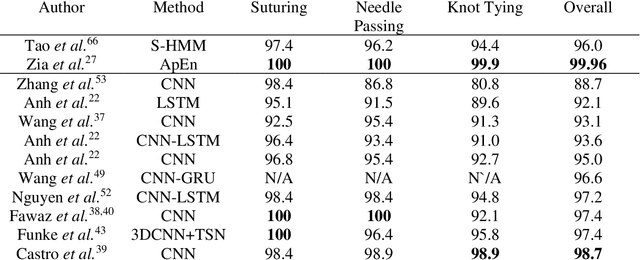
Abstract:Surgical training in medical school residency programs has followed the apprenticeship model. The learning and assessment process is inherently subjective and time-consuming. Thus, there is a need for objective methods to assess surgical skills. Here, we use the Preferred Reporting Items for Systematic Reviews and Meta-Analyses (PRISMA) guidelines to systematically survey the literature on the use of Deep Neural Networks for automated and objective surgical skill assessment, with a focus on kinematic data as putative markers of surgical competency. There is considerable recent interest in deep neural networks (DNN) due to the availability of powerful algorithms, multiple datasets, some of which are publicly available, as well as efficient computational hardware to train and host them. We have reviewed 530 papers, of which we selected 25 for this systematic review. Based on this review, we concluded that DNNs are powerful tools for automated, objective surgical skill assessment using both kinematic and video data. The field would benefit from large, publicly available, annotated datasets that are representative of the surgical trainee and expert demographics and multimodal data beyond kinematics and videos.
Deep Learning in Medical Image Registration: A Survey
Mar 05, 2019



Abstract:The establishment of image correspondence through robust image registration is critical to many clinical tasks such as image fusion, organ atlas creation, and tumor growth monitoring, and is a very challenging problem. Since the beginning of the recent deep learning renaissance, the medical imaging research community has developed deep learning based approaches and achieved the state-of-the-art in many applications, including image registration. The rapid adoption of deep learning for image registration applications over the past few years necessitates a comprehensive summary and outlook, which is the main scope of this survey. This requires placing a focus on the different research areas as well as highlighting challenges that practitioners face. This survey, therefore, outlines the evolution of deep learning based medical image registration in the context of both research challenges and relevant innovations in the past few years. Further, this survey highlights future research directions to show how this field may be possibly moved forward to the next level.
Knowledge-based Analysis for Mortality Prediction from CT Images
Feb 20, 2019
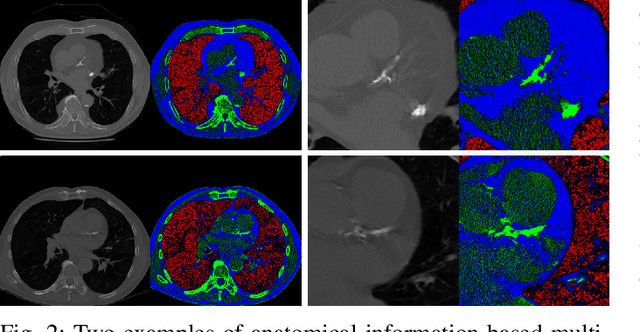


Abstract:Recent studies have highlighted the high correlation between cardiovascular diseases (CVD) and lung cancer, and both are associated with significant morbidity and mortality. Low-Dose CT (LCDT) scans have led to significant improvements in the accuracy of lung cancer diagnosis and thus the reduction of cancer deaths. However, the high correlation between lung cancer and CVD has not been well explored for mortality prediction. This paper introduces a knowledge-based analytical method using deep convolutional neural network (CNN) for all-cause mortality prediction. The underlying approach combines structural image features extracted from CNNs, based on LDCT volume in different scale, and clinical knowledge obtained from quantitative measurements, to comprehensively predict the mortality risk of lung cancer screening subjects. The introduced method is referred to here as the Knowledge-based Analysis of Mortality Prediction Network, or KAMP-Net. It constitutes a collaborative framework that utilizes both imaging features and anatomical information, instead of completely relying on automatic feature extraction. Our work demonstrates the feasibility of incorporating quantitative clinical measurements to assist CNNs in all-cause mortality prediction from chest LDCT images. The results of this study confirm that radiologist defined features are an important complement to CNNs to achieve a more comprehensive feature extraction. Thus, the proposed KAMP-Net has shown to achieve a superior performance when compared to other methods.
Can Deep Learning Outperform Modern Commercial CT Image Reconstruction Methods?
Nov 08, 2018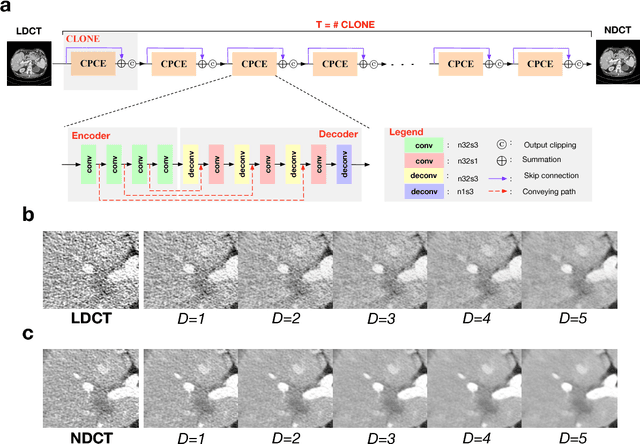

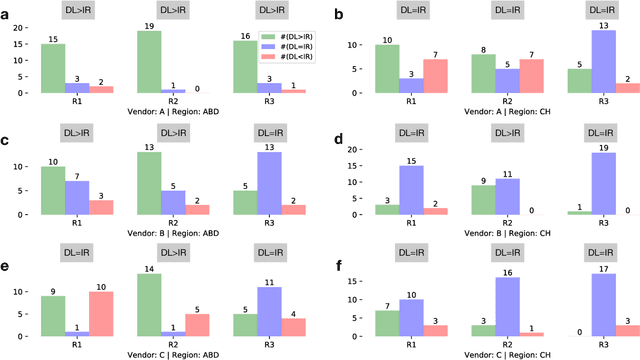

Abstract:Commercial iterative reconstruction techniques on modern CT scanners target radiation dose reduction but there are lingering concerns over their impact on image appearance and low contrast detectability. Recently, machine learning, especially deep learning, has been actively investigated for CT. Here we design a novel neural network architecture for low-dose CT (LDCT) and compare it with commercial iterative reconstruction methods used for standard of care CT. While popular neural networks are trained for end-to-end mapping, driven by big data, our novel neural network is intended for end-to-process mapping so that intermediate image targets are obtained with the associated search gradients along which the final image targets are gradually reached. This learned dynamic process allows to include radiologists in the training loop to optimize the LDCT denoising workflow in a task-specific fashion with the denoising depth as a key parameter. Our progressive denoising network was trained with the Mayo LDCT Challenge Dataset, and tested on images of the chest and abdominal regions scanned on the CT scanners made by three leading CT vendors. The best deep learning based reconstructions are systematically compared to the best iterative reconstructions in a double-blinded reader study. It is found that our deep learning approach performs either comparably or favorably in terms of noise suppression and structural fidelity, and runs orders of magnitude faster than the commercial iterative CT reconstruction algorithms.
Learning Deep Similarity Metric for 3D MR-TRUS Registration
Oct 15, 2018



Abstract:Purpose: The fusion of transrectal ultrasound (TRUS) and magnetic resonance (MR) images for guiding targeted prostate biopsy has significantly improved the biopsy yield of aggressive cancers. A key component of MR-TRUS fusion is image registration. However, it is very challenging to obtain a robust automatic MR-TRUS registration due to the large appearance difference between the two imaging modalities. The work presented in this paper aims to tackle this problem by addressing two challenges: (i) the definition of a suitable similarity metric and (ii) the determination of a suitable optimization strategy. Methods: This work proposes the use of a deep convolutional neural network to learn a similarity metric for MR-TRUS registration. We also use a composite optimization strategy that explores the solution space in order to search for a suitable initialization for the second-order optimization of the learned metric. Further, a multi-pass approach is used in order to smooth the metric for optimization. Results: The learned similarity metric outperforms the classical mutual information and also the state-of-the-art MIND feature based methods. The results indicate that the overall registration framework has a large capture range. The proposed deep similarity metric based approach obtained a mean TRE of 3.86mm (with an initial TRE of 16mm) for this challenging problem. Conclusion: A similarity metric that is learned using a deep neural network can be used to assess the quality of any given image registration and can be used in conjunction with the aforementioned optimization framework to perform automatic registration that is robust to poor initialization.
3D Convolutional Encoder-Decoder Network for Low-Dose CT via Transfer Learning from a 2D Trained Network
Apr 29, 2018
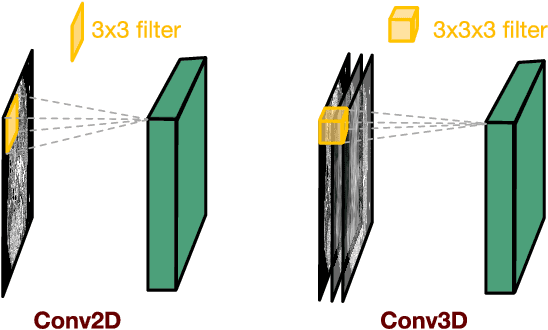
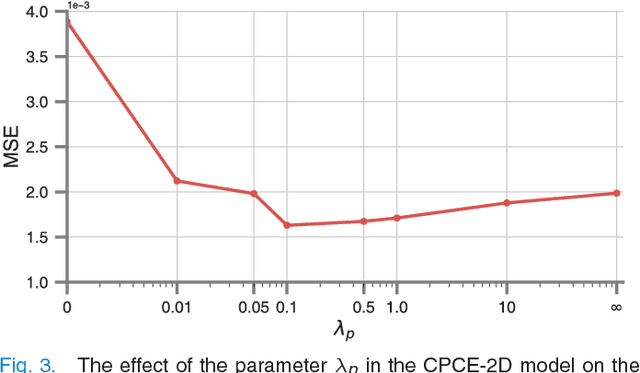

Abstract:Low-dose computed tomography (CT) has attracted a major attention in the medical imaging field, since CT-associated x-ray radiation carries health risks for patients. The reduction of CT radiation dose, however, compromises the signal-to-noise ratio, and may compromise the image quality and the diagnostic performance. Recently, deep-learning-based algorithms have achieved promising results in low-dose CT denoising, especially convolutional neural network (CNN) and generative adversarial network (GAN). This article introduces a Contracting Path-based Convolutional Encoder-decoder (CPCE) network in 2D and 3D configurations within the GAN framework for low-dose CT denoising. A novel feature of our approach is that an initial 3D CPCE denoising model can be directly obtained by extending a trained 2D CNN and then fine-tuned to incorporate 3D spatial information from adjacent slices. Based on the transfer learning from 2D to 3D, the 3D network converges faster and achieves a better denoising performance than that trained from scratch. By comparing the CPCE with recently published methods based on the simulated Mayo dataset and the real MGH dataset, we demonstrate that the 3D CPCE denoising model has a better performance, suppressing image noise and preserving subtle structures.
 Add to Chrome
Add to Chrome Add to Firefox
Add to Firefox Add to Edge
Add to Edge